Beyond the thrust curve, there is an art to the color of the propellant (achieved through special metal salt additives).
My 9 ft tall Sledgehammer, lifting off on a M1550 Redline motor from Aerotech, one of my favorite photos:
The shadow of dusk in the foreground really lets the color pop. The smoke and dust is not red, but looks like cotton candy illuminated by the intensely bright red flame.
Here is a picture perfect launch of my V2.0 with an L730 motor imported from Cesaroni, a Canadian aerospace & defense company. Their unique thermoplastic propellant burns cleanly (few additives), showing multiple shock diamonds. In the foreground is a videocam on tripod for scale. Black Rock is in the distance:
This V2 photo is also the current cover of Sport Rocketry magazine.
In the past year, Aerotech introduced Mohave Green, and Erik captured my Thug's final supersonic flight (the motor literally presses up against the nose cone of this stubby rocket:
My night launch is with the Green Gorilla propellant from Animal Motor Works (AMW) in the Black Rock Desert.
Metal ions combine with electrons in the flame, and the metal atoms are raised to excited states because of the high flame temperature. Upon returning to the ground state, they give off light (from their line spectrum) characteristic of that metal. The ions come from metal chlorides: Barium Chloride (BaCl) for green, Copper Chloride (CuCl) for blue, or Strontium Chloride (SrCl) for red. These metal chlorides generally do not exist at room temperature or are too reactive to add as an additive, so precursors are mixed in, and they react during the burn to create the desired molecules. The Chlorine comes from the Ammonium Perchlorate oxidizer for free, and one need only add metal salts such as nitrates or carbonates to provide the metal (unfortunately, they are hygroscopic and have less energy content than the APCP oxidizer, so as with most additives, they tend to be more show and less go). So, for example, Barium Nitrate is the additive that forms BaCl during the burn to emit a laser-like green in the flame.
Titanium sponge gives a sparky motor, like the AMW Skidmark one I launched on Sunday, followed by one by Vern and my buddy Erik at dusk:
The sparks exact a huge penalty on performance though, adding weight, soaking up heat to get them white hot, and adding almost nothing to the thrust.
And in contrast to the plume colors, one can go for all smoke and no fire, as seen in this cluster of three smokey Blackjacks:
Most of the white "smoke" behind a rocket is actually water vapor like a cloud condensed on the hyrdrochloric acid micro-droplets in the exhaust.
White smoke can be enhanced with zinc dust and black smoke from a unbalanced fuel/oxidizer ratio where the fuel does not burn completely and leaves the nozzle as smoke. The smokey motors are some of the least efficient - "all show and no go."
- Log in to post comments


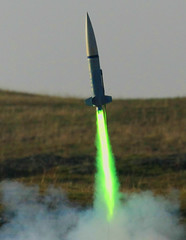

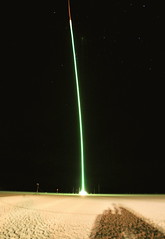
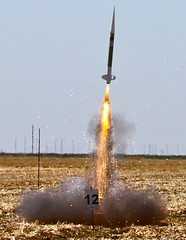
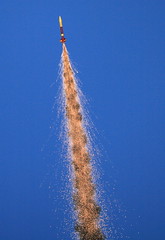
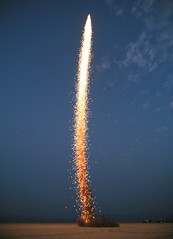

Congrats on the cover, Steve! That's a brilliant photo.
Thanks!
As they say, going up the the easy part. Here is the ballistic return of my V2:
http://www.flickr.com/photos/jurvetson/881316427/
P.S. I also added some of the science behind the rocket science in the text above.
Here is a picture perfect launch of my V2.0 with an L730 motor imported from Cesaroni, a Canadian aerospace & defense company. Their unique thermoplastic propellant burns cleanly (few additives), showing multiple shock diamonds. In the foreground is a videocam on tripod for scale. Black Rock is in the distance:
thanks..
is it is types of rocket propllaents
Congrats on the cover, Steve! That's a brilliant photo.